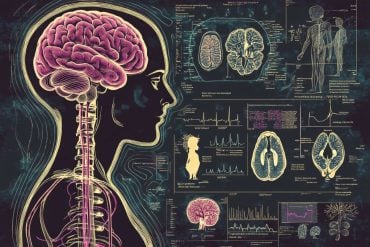Neuroscientists at UC Davis have come up with a way to observe brain activity during natural reading. It’s the first time researchers have been able to study the brain while reading actual texts, instead of individual words, and it’s already helping settle some ideas about just how we read.
The research has potential implications for understanding dyslexia and other reading deficits, Henderson said.
“It’s a key advance in understanding reading in the brain, because people are just reading normally,” said John Henderson, professor of psychology at the UC Davis Center for Mind and Brain. The work was published today in the Journal of Neuroscience.
Until now, neuroscientists have only measured brain activity as a volunteer fixes his or her attention on individual words. The signals of brain activity from functional magnetic resonance imaging, or fMRI, last for several seconds — too slow to keep up with natural reading, which processes several words a second.
Instead, Henderson and colleagues combined functional MRI with eye tracking. Lying in an MRI scanner, subjects read text on a screen while the eye-tracking device registers which word they are paying attention to at any given time. They call this new method fixation-related, or “FIRE” fMRI.

“By tracking their eye movements as they read natural paragraphs, we can know which word they are attending to, and see the neural signal for fixation on each word,” Henderson said.
Two theories of reading
The team has applied the technology to test ideas about how words are represented in the brain. There are two theories about this, Henderson said. The first holds that words are represented by connections to the real world: What does it look like, how do I handle it, how does it make me feel, reflected in brain areas for vision, touch, emotion and so on. The second theory holds that words are represented as abstract symbols that interact with each other.
To test these ideas, Henderson and colleagues scored the nouns in their test paragraphs for “manipulability”: do they refer to real objects that can be manipulated to some degree?
As volunteers read the manipulable nouns, areas of the brain that deal with manipulation and carrying out physical actions lit up, lending support to the view that words are represented in the brain by connections with real actions.
By providing a window into brain activity during natural reading, the FIRE-fMRI technique allows the UC Davis group to look at all kinds of unanswered questions, Henderson said, such as whether language and grammar are handled by a specific part of the brain, and whether the brain anticipates upcoming words as we read. These discoveries would have implications not just for human psychology but also for artificial intelligence, he said.
The research has potential implications for understanding dyslexia and other reading deficits, Henderson said.
Co-authors on the paper are Rutvik Desai and Vicky Lai, University of South Carolina; and Wonil Choi at the UC Davis Center for Mind and Brain.
Funding: The work was supported by grants from the National Science Foundation and National Institutes of Health.
Source: Karen Nikos-Rose – UC Davis
Image Credit: The image is credited to Karin Higgins, UC Davis.
Original Research: Abstract for “Toward Semantics in the Wild: Activation to Manipulable Nouns in Naturalistic Reading” by Rutvik H. Desai, Wonil Choi, Vicky T. Lai, and John M. Henderson in Journal of Neuroscience. Published online April 6 2016 doi:10.1523/JNEUROSCI.1480-15.2016
Abstract
Toward Semantics in the Wild: Activation to Manipulable Nouns in Naturalistic Reading
The neural basis of language processing, in the context of naturalistic reading of connected text, is a crucial but largely unexplored area. Here we combined functional MRI and eye tracking to examine the reading of text presented as whole paragraphs in two experiments with human subjects. We registered high-temporal resolution eye-tracking data to a low-temporal resolution BOLD signal to extract responses to single words during naturalistic reading where two to four words are typically processed per second. As a test case of a lexical variable, we examined the response to noun manipulability. In both experiments, signal in the left anterior inferior parietal lobule and posterior inferior temporal gyrus and sulcus was positively correlated with noun manipulability. These regions are associated with both action performance and action semantics, and their activation is consistent with a number of previous studies involving tool words and physical tool use. The results show that even during rapid reading of connected text, where semantics of words may be activated only partially, the meaning of manipulable nouns is grounded in action performance systems. This supports the grounded cognition view of semantics, which posits a close link between sensory–motor and conceptual systems of the brain. On the methodological front, these results demonstrate that BOLD responses to lexical variables during naturalistic reading can be extracted by simultaneous use of eye tracking. This opens up new avenues for the study of language and reading in the context of connected text.
SIGNIFICANCE STATEMENT The study of language and reading has traditionally relied on single word or sentence stimuli. In fMRI, this is necessitated by the fact that time resolution of a BOLD signal much lower than that of cognitive processes that take place during natural reading of connected text. Here, we propose a method that combines eye tracking and fMRI, and can extract word-level information from the BOLD signal using high-temporal resolution eye tracking. In two experiments, we demonstrate the method by analyzing the activation of manipulable nouns as subjects naturally read paragraphs of text in the scanner, showing the involvement of action/motion perception areas. This opens up new avenues for studying neural correlates of language and reading in more ecologically realistic contexts.
“Toward Semantics in the Wild: Activation to Manipulable Nouns in Naturalistic Reading” by Rutvik H. Desai, Wonil Choi, Vicky T. Lai, and John M. Henderson in Journal of Neuroscience. Published online April 6 2016 doi:10.1523/JNEUROSCI.1480-15.2016






